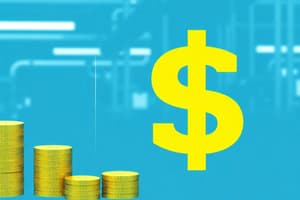Podcast
Questions and Answers
A firm aims to produce a target output level. How does it determine the optimal combination of factors to use?
A firm aims to produce a target output level. How does it determine the optimal combination of factors to use?
- By selecting the combination that uses the most of each factor.
- By choosing the combination that produces the target output at the lowest possible cost. (correct)
- By randomly selecting a combination of factors.
- By choosing the combination that maximizes output regardless of cost.
What does the cost function of a firm measure?
What does the cost function of a firm measure?
- The minimum cost of producing a given level of output. (correct)
- The average cost of producing a given level of output.
- The total revenue earned from selling a given level of output.
- The maximum cost of producing a given level of output.
In the context of cost minimization, what are the key decision variables for a firm?
In the context of cost minimization, what are the key decision variables for a firm?
- The quantities of factors 1 and 2 used in production. (correct)
- The level of target output and the wage rate.
- The prices of factors 1 and 2.
- The prices of the output and the level of advertising.
What is the objective of the cost minimization problem?
What is the objective of the cost minimization problem?
A firm's production function is given by $f(x_1, x_2) = y$, where $x_1$ and $x_2$ are the amounts of factor 1 and factor 2 used, respectively. The prices of the factors are $w_1$ and $w_2$. What is the total cost equation?
A firm's production function is given by $f(x_1, x_2) = y$, where $x_1$ and $x_2$ are the amounts of factor 1 and factor 2 used, respectively. The prices of the factors are $w_1$ and $w_2$. What is the total cost equation?
What does it mean for a firm to have a short-run cost function?
What does it mean for a firm to have a short-run cost function?
What is the key difference between the short-run and long-run cost functions?
What is the key difference between the short-run and long-run cost functions?
In the short run, with factor 2 fixed at $\bar{x_2}$, what is the firm's cost minimization problem?
In the short run, with factor 2 fixed at $\bar{x_2}$, what is the firm's cost minimization problem?
What does the solution to the short-run cost minimization problem provide?
What does the solution to the short-run cost minimization problem provide?
A firm's short-run cost function, given factor 2 is fixed at $\bar{x_2}$, is $C(w_1, w_2, y, \bar{x_2}) = w_1x_1^(w_1, w_2, y, \bar{x_2}) + w_2\bar{x_2}$. What does the expression $x_1^(w_1, w_2, y, \bar{x_2})$ represent?
A firm's short-run cost function, given factor 2 is fixed at $\bar{x_2}$, is $C(w_1, w_2, y, \bar{x_2}) = w_1x_1^(w_1, w_2, y, \bar{x_2}) + w_2\bar{x_2}$. What does the expression $x_1^(w_1, w_2, y, \bar{x_2})$ represent?
In the long run, how does a firm determine the optimal levels of factors 1 and 2 ($x_1$ and $x_2$) to use?
In the long run, how does a firm determine the optimal levels of factors 1 and 2 ($x_1$ and $x_2$) to use?
Given the long-run conditional factor demands $x_1(w_1, w_2, y)$ and $x_2(w_1, w_2, y)$, how is the long-run cost function, $C(w_1, w_2, y)$ determined?
Given the long-run conditional factor demands $x_1(w_1, w_2, y)$ and $x_2(w_1, w_2, y)$, how is the long-run cost function, $C(w_1, w_2, y)$ determined?
What is the cost function for a perfect complements production function where $f(x_1, x_2) = min{x_1, x_2}$?
What is the cost function for a perfect complements production function where $f(x_1, x_2) = min{x_1, x_2}$?
For a production function $f(x_1, x_2) = min{x_1, x_2}$, which statement is correct about the conditional factor demands?
For a production function $f(x_1, x_2) = min{x_1, x_2}$, which statement is correct about the conditional factor demands?
For a production function $f(x_1, x_2) = x_1 + x_2$, representing perfect substitutes, how does the firm decide which factor to use?
For a production function $f(x_1, x_2) = x_1 + x_2$, representing perfect substitutes, how does the firm decide which factor to use?
For a production function $f(x_1, x_2) = x_1 + x_2$, what does the cost function equal if $w_1 < w_2$?
For a production function $f(x_1, x_2) = x_1 + x_2$, what does the cost function equal if $w_1 < w_2$?
What is the general form of a Cobb-Douglas production function?
What is the general form of a Cobb-Douglas production function?
Suppose a firm's long-run cost function is given by $C(w_1, w_2, y)$. If factor 2 is fixed in the short run, how can the short-run cost function be expressed?
Suppose a firm's long-run cost function is given by $C(w_1, w_2, y)$. If factor 2 is fixed in the short run, how can the short-run cost function be expressed?
What is the relationship between the short-run and long-run cost-minimizing amounts of the variable factor if the fixed factor is set at its long-run cost-minimizing level?
What is the relationship between the short-run and long-run cost-minimizing amounts of the variable factor if the fixed factor is set at its long-run cost-minimizing level?
Define variable costs.
Define variable costs.
Define fixed costs.
Define fixed costs.
In the short run, what is the total cost of a firm equal to?
In the short run, what is the total cost of a firm equal to?
If the fixed cost does not depend on the output, then in the short run what is the change in the total costs for an additional unit of output equal to
If the fixed cost does not depend on the output, then in the short run what is the change in the total costs for an additional unit of output equal to
A firm's cost function is given by $C(y)$, variable cost function by $C_v(y)$, and fixed costs by $F$. Which of the following expressions is correct?
A firm's cost function is given by $C(y)$, variable cost function by $C_v(y)$, and fixed costs by $F$. Which of the following expressions is correct?
What is the mathematical expression for Marginal Cost (MC)?
What is the mathematical expression for Marginal Cost (MC)?
What is Average Cost (AC)?
What is Average Cost (AC)?
In the context of cost curves, what does AFC represent?
In the context of cost curves, what does AFC represent?
If total fixed costs are constant, what happens to Average Fixed Cost (AFC) as output (y) increases?
If total fixed costs are constant, what happens to Average Fixed Cost (AFC) as output (y) increases?
A textile factory has fixed plant size, but can vary its labor. If the cost of labor increases, what is the likely effect on the average variable cost (AVC)?
A textile factory has fixed plant size, but can vary its labor. If the cost of labor increases, what is the likely effect on the average variable cost (AVC)?
Which statement describes the typical shape of the Average Fixed Cost (AFC) curve?
Which statement describes the typical shape of the Average Fixed Cost (AFC) curve?
What is a typical shape of the Average Variable Cost (AVC) curve?
What is a typical shape of the Average Variable Cost (AVC) curve?
How is the Marginal Cost (MC) curve related to the Variable Cost (VC) curve?
How is the Marginal Cost (MC) curve related to the Variable Cost (VC) curve?
Marginal Cost (MC) represents:
Marginal Cost (MC) represents:
If $VC(y) = y^2$, what is the Marginal Cost (MC)?
If $VC(y) = y^2$, what is the Marginal Cost (MC)?
How is the area beneath the Marginal Cost (MC) curve, up to a given quantity y, best described?
How is the area beneath the Marginal Cost (MC) curve, up to a given quantity y, best described?
The firm's demand curve in a perfectly competitive market is:
The firm's demand curve in a perfectly competitive market is:
If a firm in a perfectly competitive market charges a price higher than the market price:
If a firm in a perfectly competitive market charges a price higher than the market price:
If $P\lt p^$ (where $p^$ is the existing market price) what happens, according to the theory of Perfect Competition?
If $P\lt p^$ (where $p^$ is the existing market price) what happens, according to the theory of Perfect Competition?
What does behavioral assumption say about firms?
What does behavioral assumption say about firms?
What is first step to know to maximize the profit?
What is first step to know to maximize the profit?
In a perfectly competitive market, what is a firm's profit-maximizing decision?
In a perfectly competitive market, what is a firm's profit-maximizing decision?
In a competitive market, a firm chooses the quantity, such that the marginal revenue = marginal cost. What happens if MR > MC?
In a competitive market, a firm chooses the quantity, such that the marginal revenue = marginal cost. What happens if MR > MC?
Flashcards
Cost Minimization
Cost Minimization
Choosing factor combinations to produce target output at the lowest possible cost.
Cost Function
Cost Function
A function that measures the minimum cost of producing a certain quantity of output when factor prices are given
Short run cost minimization
Short run cost minimization
Cost minimization when at least one production factor is fixed.
Long run cost minimization
Long run cost minimization
Signup and view all the flashcards
Short-Run Cost Function
Short-Run Cost Function
Signup and view all the flashcards
Long-Run Cost Function
Long-Run Cost Function
Signup and view all the flashcards
Fixed Costs
Fixed Costs
Signup and view all the flashcards
Variable Costs
Variable Costs
Signup and view all the flashcards
Marginal Cost
Marginal Cost
Signup and view all the flashcards
Average Cost
Average Cost
Signup and view all the flashcards
Average Variable Cost
Average Variable Cost
Signup and view all the flashcards
Average Fixed Cost
Average Fixed Cost
Signup and view all the flashcards
Perfect competition
Perfect competition
Signup and view all the flashcards
Monopoly
Monopoly
Signup and view all the flashcards
Oligopoly
Oligopoly
Signup and view all the flashcards
Price taker
Price taker
Signup and view all the flashcards
Competitive Firm's Demand Curve
Competitive Firm's Demand Curve
Signup and view all the flashcards
Cost Function
Cost Function
Signup and view all the flashcards
Firm decisions in competitive market
Firm decisions in competitive market
Signup and view all the flashcards
Profit Maximization in Perfect Competition
Profit Maximization in Perfect Competition
Signup and view all the flashcards
Condition for profits maximization
Condition for profits maximization
Signup and view all the flashcards
Entry of New Firms
Entry of New Firms
Signup and view all the flashcards
Firms Exit the Market
Firms Exit the Market
Signup and view all the flashcards
Supply Curve
Supply Curve
Signup and view all the flashcards
Entry and Exit affect
Entry and Exit affect
Signup and view all the flashcards
Perfect Efficiency
Perfect Efficiency
Signup and view all the flashcards
Monopolist Decision
Monopolist Decision
Signup and view all the flashcards
Describe a monopolist
Describe a monopolist
Signup and view all the flashcards
Social Optimum
Social Optimum
Signup and view all the flashcards
Study Notes
- Cost function is an equation that gives the cost to product some final amount
- Cost minimization aims to find the lowest combination for total expense
- Cost minimization problem involves choosing amounts of Factor 1 and Factor 2 to hit a target while minimizing total expense
Cost Minimization
- How does the firm decide which combination to use?
- The firm chooses the combination of factors that produce the target output at the lowest possible cost
min W1X1 + W2X2subject tof(X1,X2) = y- X1 and X2 are the amounts of Factor 1 and Factor 2 used
Cost Function
- The solution to a cost-minimization problem depends on how expensive W1, W2, and y are
- Denoted as
C(W1, W2, y) - It measures the minimum cost of producing y units when factor prices are W1 and W2
- Short-run vs long-run cost minimization occurs based on adjustable costs
Short Run Cost Function
- It is defined as the minimum cost to produce a given level of output while adjusting only the variable factors of production
- Production Function = f(x1,x2) = y
Long Run Cost Function
- A long run cost function gives the minimum cost of producing a given level of output, adjusting all the factors of productions
- The conditional factor demands are
- X1 = x1(W1, W2, y)
- X2 = x2(W1, W2, y)
- Long-run cost function,
C(W1, W2, y) = W1X1 * (W1, W2, y) + W2X2 * (W1, W2, y)- This substitutes the conditional factor demands into the cost equation
Short Run Cost
- Suppose factor 2 is fixed at X2
- The firm's short-run cost minimization problem involves W1X1 + W2X2
- Minimum cost is: min x1 W1X1 + W2X2 subject to f(x1, X2) = y
Types of Production Functions
Perfect Compliments Production Function
f(x1, x2) = min{x1, x2}- Cost function is C(W1, W2, y) = (W1 + W2)y
Perfect Substitutes Production Function
f(x1, x2) = x1 + x2- The conditional factor demands are
- x1(W1, W2, y) = y
- x2(W1, W2, y) = 0 if W1 < W2
- x1(W1, W2, y) = 0
- x2(W1, W2, y) = y if W1 > W2
Cobb-Douglas production function
f(x1, x2) = x^a * x^bwhere a > 0, b > 0
Firm Linkage
- The long-run conditional demands are used to connect Short run and Long run cost function
- Suppose X2 is fixed in the short run, then
C(W1, W2, y) = Cs (W1, W2, X2 (W1, W2, y), y) - Variable = minimum cost when factor 2 is fixed at the level that minimizes long-run costs.
Cost Curves
- In the short run some factors are Variable while others are fixed.
- Variable cost is the cost incurred from using the Variable factor
- Variable cost = W1 * X1(W1, W2, y) for factor 1
- In the short run, the total cost of a firm is C(y) = Cv(y) + F, where Cv is variable cost and F is fixed cost
Long Run
- In the long run, all factors are variable, which means F=0
Marginal Cost
- Marginal cost is the slope of the variable cost curve
Average Cost Curves
- Average Cost = AC(y) = C(y)/y, measures the cost per unit of output
- Average Variable Cost function measures the variable costs per unit of output
- Average Variable Cost = AVC(y) = Cv(y) / y
- Average Fixed Cost measures the fixed cost per unit of output
- Average Fixed Cost Formula, AFC(y) = f/y
- Average cost= Average Variable Cost + Average Fixed Cost
Cost Curve
- Average Fixed Cost AFC(y) downward sloping
- When AVC (4) is graphed there is Upward Sloping section
- The cost curve AC(y) is shown as AVC(y) to reflect the rate value change
Marginal Cost(MC) curve
- It is the slope of the VC(y) curve
- the increased Ve for MC for any addition put = "12.
- Total cost is C(y) =Cu(y) + f, VC Curve is shifted up
- Graphically Marginal Cost Is show to intersect total cost TC
Cost Minimization:
-The Area Beneath the MC curve-up to y gives the VC of producing of output M(;ly) = "34 , V(4) =- Cu(y)
Studying That Suits You
Use AI to generate personalized quizzes and flashcards to suit your learning preferences.




